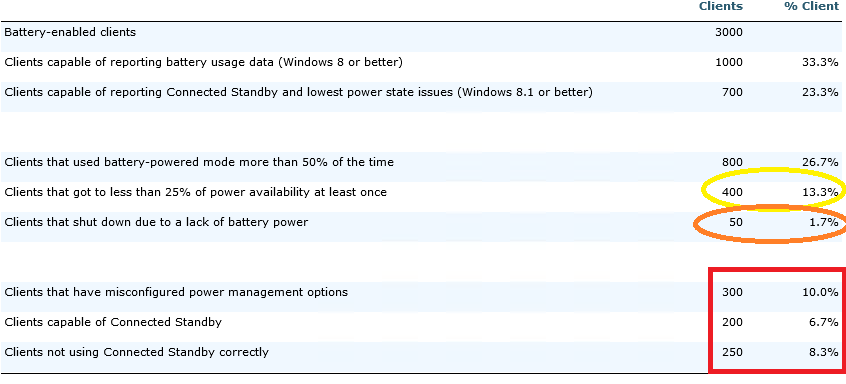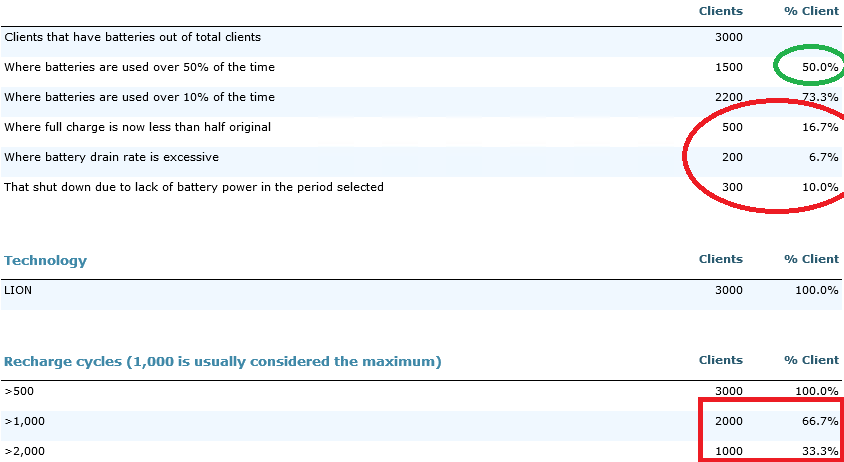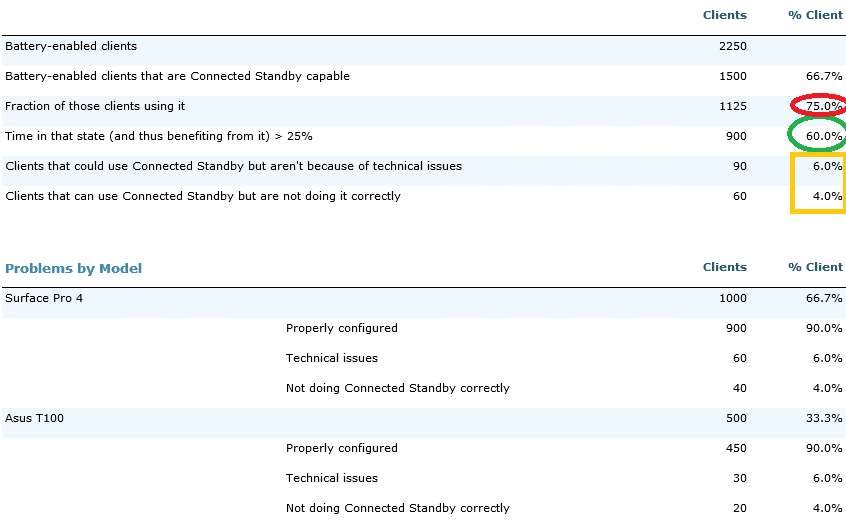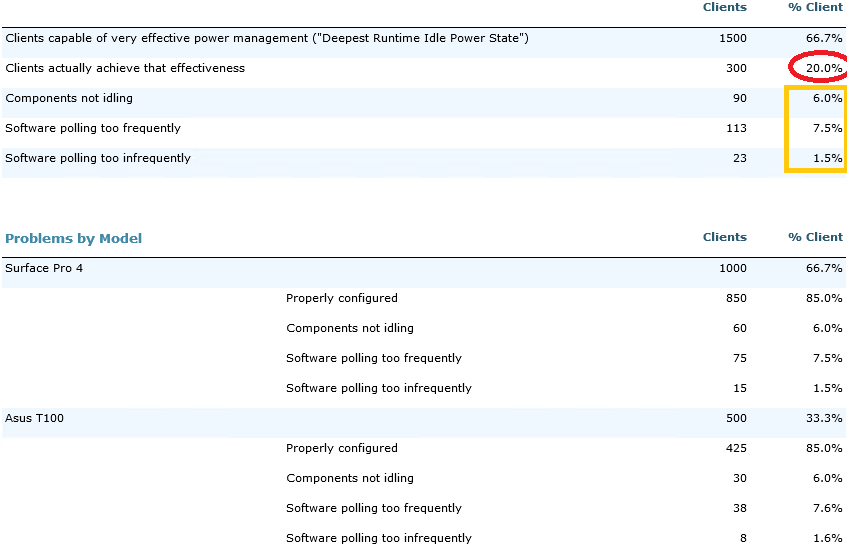Using Power Optimization reports to maximize the benefits of battery-enabled devices
Your organization has likely used laptops and ultrabooks for a long time, probably in large numbers. You might also be using tablets, convertibles, two-in-one's, or similar devices. Such computers are intended to be very mobile and thus include batteries for power especially when the user is away from their desk. Generally the battery-related functionality works well but there can be issues. NightWatchman Power Optimization allows you to understand how well such functionality is working and to proactively correct problems.
Issues related to battery-enabled devices include:
Batteries do not last forever - repeated discharging and recharching breaks down their chemistry
Batteries have finite power and thus might not have enough capacity for how your users use the devices
Modern devices can provide a smartphone-like experience (connected even when on standby, very long battery life when on standby, and true instant-on productivity). However, that functionality can have problems:
The device might not be connected to the network when on standby and therefore incoming notifications are missed
Similarly, when the device is turned back on a sync cycle must be done to update the e-mail inbox and similar data sources, delaying the user
Deepest standby might not be achieved and so the battery is drained faster than it should when on standby
Even if the device is connected while on standby, it might check for new data too frequently, draining the battery unnecessarily. Or it might check too infrequently, causing the user to have to sync the device when it's powered on.
Those issues cause problems for your organizations in several ways:
User productivity and satisfaction is decreased. Users cannot be productive when they want to or need to, and could be seriously frustrated
You are not getting full value from the new technologies you're deploying
The helpdesk has to work on issues that should be proactively corrected
You cannot proactively budget to replace batteries (or devices) as the batteries reach end of life
Or you are replacing batteries and devices before they have actually neared end of life.
By using NightWatchman Power Optimization reports you can determine the extent of such problems in your organization. You might find that some problems are more common in some business units or regions, possibly reflecting the special behavior and needs of those users, or the device choices they have made.
You can work with the people responsible for selecting and purchasing devices to ensure they are acquiring the models that you have seen to work best in your organization. They can discontinue the acquisition of devices that are performing poorly. You can also ensure that the finance people have budgeted appropriately based on the battery decline your users' devices are actually experiencing.
Where you find configuration issues, you can work with your organization's technical specialists to update firmware, drivers, or configuration details. You might also identify software that behaves poorly and that should be reconfigured, updated, or replaced.
Note
For computers with multiple batteries, the battery-related statistics reflect the aggregate of the batteries, as opposed to the individual batteries. For example, a computer where one battery got to 40% of capacity for one battery and 75% of capacity for the second battery would not be considered to have gotten to less than 50% of capacity (because the average of the two is 57.5%).
To understand more about battery-enabled devices please refer to Understanding Power Optimization.
Opportunities to improve your battery enabled devices
The following reports illustrate hypothetical examples of battery-enabled issues at an organization with over 12,000 clients. On this page we have:
Power Optimization summary
The Power Optimization Summary report shows you a quick summary of your battery-related devices and a quick overview of the issues that your other Power Optimization reports might indicate. It's a good place to start, or to share with people who only need an overview.
In this example we can see that a sizable fraction (26.7%) of this organization's battery-enabled devices are used while on battery over half the time. This organization uses such devices quite substantially and should ensure they regularly review their Power Optimization reports.
We also see that 13.3% of such devices get to less than 25% battery power availability during the week. Thus their users might be spending more time than they should worrying about battery levels and ensuring the devices are charged. Fortunately only 1.7% actually run out of battery each week, which is unfortunate but probably acceptable.
Of their devices that are capable of a smartphone-like experience, they do have substantial fractions experiencing technical problems. Those should be corrected.
 |
Battery details
In this example we can better understand the batteries being used by laptops, ultrabooks, and devices. In this case we can see that some users do experience battery-related issues, with the worst being that 16.7% of devices are getting less than half their original charge capacity. In other words, computers that used to last 4 hours on a charge now last only 2 hours. That's got to be frustrating and will only get worse in the coming months. They should plan to replace those batteries or devices.
The red box further reinforces that point by demonstrating that very high fractions of computers have batteries that have been cycled (discharged/recharged) more than is usually acceptable.
 |
Connected Standby
The following example shows an organization with many 'modern' devices (tablets, 2-in-1's, etc.) and that they are being used that way. However, there are substantial fractions that are having technical issues that should be investigated.
The issues are broken down by model so that they can determine whether certain models work better for this organization than others. In this case only two models are being used, and they're behaving the same. However, in both cases there are clients that aren't able to provide their users with the benefits of connected standby. Those users might be missing Skype calls, instant messages, or similar notifications when they shouldn't. That should be corrected.
We also see that some devices are using connected standby but are connecting too frequently or not frequently enough. Those users either have to sync their devices unnecessarily when they first start them, or the battery is draining faster than it should. The next report will distinguish between those two possibilties.
 |
Lowest power state
The devices that are capable of the lowest power state could use as little as 50 milliamps per hour while in standby (while still being connected) if they are configured properly. That's much better than the typical 300 milliamps per hour than traditional standby uses on them. In this example we see an organization where the lowest power state is almost never being achieved when it should.
We can see in the orange box that some issue is due to components not idling properly. That could be due to bad firmware or device drivers. It could also be due to bad hardware design.
Other devices are either checking for new e-mails etc. while in standby too frequently, causing the battery to drain too fast. Others are checking too infrequently, causing the users to sync e-mail on power up before they can get their latest messages.
 |
Next steps
To investigate issues such as those illustrated, you should get a list of affected computers from the NightWatchman database. This set of SQL queries allows you to do that: Power Optimization Details.sql. You can then check a small subset of those computers to understand the root cause or causes. If all or most of the computers in the subset you check all have one or two root causes, it's reasonable to extrapolate that those are the root causes of the issue as a whole. The size of the subset depends on how consistent the issue is and how comfortable you are with the explanation. Often 5 to 15 computers are enough, but you might want to check 30 or more. Depending on the nature of the issue, you might check the powercfg.exe reports on their computers, look for new device drivers or firmware from the vendors, or review the software and configuration of the computers.